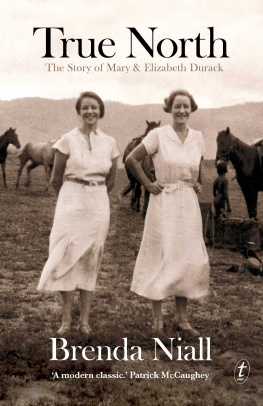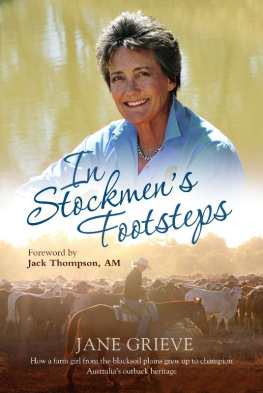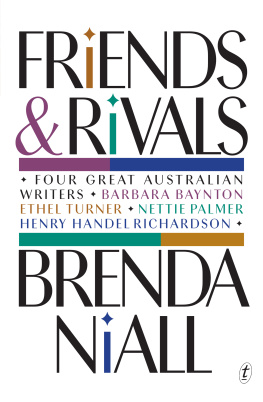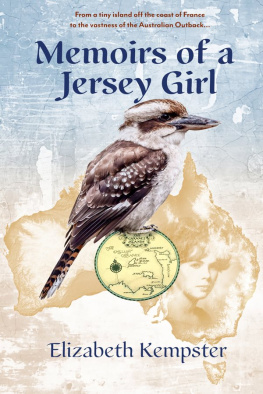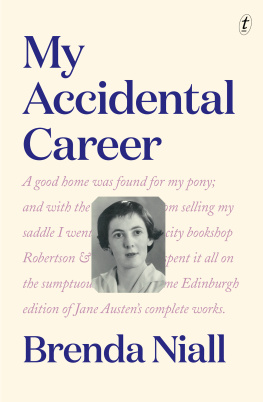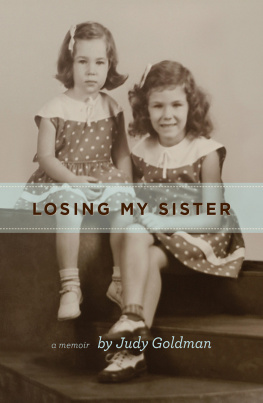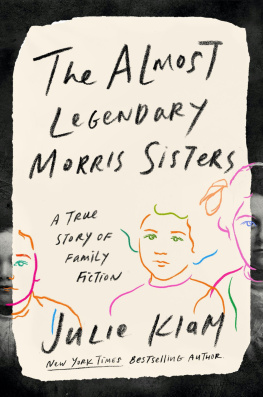PRAISE FOR BRENDA NIALL AND TRUE NORTH
There is so much to admire and enjoy in this profoundly interesting biography. As a picture of Perth society in the first half of the twentieth century it is as good as anything I know. As a sympathetic portrait of the difficulty women as mothers had to be creative and absorbed in their work, it is profoundly moving. As a picture of a rare closeness between two sisters it is, if anything, enviable. Brenda Niall could not write a poor book. But this is, quite simply, one of her very best. Canberra Times
Their relationship is brilliantly, vividly evokedtheir deep connection to the far north, their abiding spiritual home, and their connection to the Aborigines make the book a modern classicIt is all written so fluently and seamlessly that I am quite lost in admirationA distinctive and distinguished Australian book. Patrick McCaughey
A sensitive and well researched exploration of the interaction between creative artists and their significant environment. Geoffrey Bolton
Brenda Niall has produced a graceful and perceptive biography of two extraordinary creative women. She treads carefully through the minefield of controversies about their familys exploitation of Aboriginal labour, as well as their own interventions in Indigenous art and politics. Her brief portraits of other members of the family, especially the two brothers who dedicated their lives to improving the land up north and their Lear-like father, are an additional bonus to this absorbing book. Australian Book Review
A compelling Australian story that is just as relevant to todays social fabric as it was when it first began more than 130 years ago. Courier-Mail
Readable, moving, sympathetic but not uncriticalA celebration of place as well as two extraordinary women. Irish Echo
A rich portrait of two complex and inter-connected livesAnd throughout is the marvellous incisive Niall ability to distil, to capture the essence of a situation or problem, to ask the penetrating questions, to display sympathy and empathy but never to shirk criticism or to be afraid of exposing frailty. The individual portraits are beautifully drawn and very nicely contrasted with both the sisters emerging as their own person but yet with much that is sharedThe book breaks important new ground. It is celebratory but far from uncritical and it confronts complexity on every page. John Thompson
Meticulously researched and highly readable. Readings Monthly
Brenda Niall has written perceptively about the different but complementary personalities of Mary and Elizabeth. She has done the two sisters proud in this splendid and informative work. Catholic Weekly
Brenda Niall is one of Australias foremost biographers. She is the author of eleven books including seven acclaimed biographies. Four have won multiple awards, among them her renowned accounts of the Boyd family. In 2004 Brenda was awarded the Order of Australia for services to Australian literature, as an academic, biographer and literary critic. She lives in Melbourne and frequently reviews for the Age, Sydney Morning Herald and Australian Book Review.
Photographs courtesy of Patsy Millett and Perpetua Durack Clancy.
textpublishing.com.au
The Text Publishing Company
Swann House
22 William Street
Melbourne Victoria 3000
Australia
Copyright Brenda Niall 2012
All rights reserved. Without limiting the rights under copyright above, no part of this publication shall be reproduced, stored in or introduced into a retrieval system, or transmitted in any form or by any means (electronic, mechanical, photocopying, recording or otherwise), without the prior permission of both the copyright owner and the publisher of this book.
First published by The Text Publishing Company 2012, this edition 2013.
Cover and page design by W. H. Chong
Typeset by J&M Typesetters
National Library of Australia Cataloguing-in-Publication entry
Author: Niall, Brenda, 1930
Title: True north : the story of Mary and Elizabeth Durack / Brenda Niall.
ISBN: 9781922079909 (pbk.)
ISBN: 9781921921421 (ebook)
Subjects: Durack, Mary, 1913-1994.
Durack, Elizabeth, 1915-2000.
SistersAustraliaBiography.
Women authors, Australian20th century.
Women authors, Australian20th centuryBiography.
Women artistsAustralia20th century.
Women artistsAustralia20th centuryBiography.
Dewey Number: A828.309

| This project has been assisted by the Australian Government through the Australia Council for the Arts, its arts funding and advisory body. |
Before I read their letters to one another I thought of Mary and Elizabeth Duracks early creative partnership as an enticing subject for a group study of some writers and artists who worked in tandem. Marys words, Elizabeths imageshow did the collaboration work? And whose imagination gave the childrens books that they published togetherThe Way of the Whirlwind or The Magic Trumpettheir edgy, unsettling quality? With those questions in mind, I read the unpublished letters that the sisters exchanged during the Second World War, when Mary was living in Perth and Elizabeth in Sydney. Its unusual to find both sides of a long correspondence surviving intact; unusual too to hear so clearly the distinctive voices of the writers as they express strong emotions and reveal their inner selves.
These wartime letters, which the sisters later planned to publish under the title, The Young Know, gave insight into their literary-artistic partnership. But as I read more closely, I began to feel that there was a larger theme that asked to be explored. The sisters wrote longingly about the past, especially the time they had shared at Ivanhoe station in the Kimberley in the mid-1930s. But they also showed unease and concern for the future. Loving the land but well aware of wrongs done to the displaced indigenous people, they hoped that their own generation might bring about a new order.
The letters sparkle with the sisters wit and comic sense, but they have depth too. Frank and forthright in style, they show two intelligent young women grappling with issues with which few Australians of their time were concerned. When I thought about the Duracks creativity, I saw that it was inseparable from their love of the north. My subject became, almost overnight it seemed, a story about place, dispossession and imaginative possession.
True North owes a very large debt to John Thompson, biographer and historian, who first urged me to look at the remarkable Durack archive in the Battye Library, State Library of Western Australia. He said that I would be fascinated by Mary and Elizabeth; he was right. My historian sister Frances ONeill, trawling through the Durack archive with me in Perth, said: You cant waste this material. Mary and Elizabeth must have a book of their own, not just a share in a group study. She was right too. As the biography took shape, Frances read it in draft form, chapter by chapter, and I thank her for the stimulating exchange of ideas that followed and for her encouragement throughout.
The book could not have been written without the unstintingly generous cooperation of Mary Duracks daughter Patsy Millett and Elizabeth Duracks daughter Perpetua Durack Clancy. A trip to the Kimberley in their company was a delight as well as a source of insight. They contributed in uncountable ways to my understanding of my subject and saved me from many mistakes. Whatever mistakes remain are my own.
For interviews and conversations about the Duracks and the solving of research problems I thank Anne Durack Barker, Geoffrey Bolton, Susan Bradley, Veronica Brady, Michael Clancy, Mary Ryllis Clark, Helen Elliott, Robert Hester, Francis and Sarah King, Helen Muir, Maria Myers, Hugh and Maggie Niall, Philippa OBrien, Rosalie Okely, Clare ONeill and Terry ONeill.

